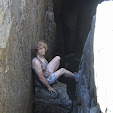Ok, ok, I know, this is an Arkansas trip and I'm traveling between two cities in Missouri. Missouri is a big state, not that easily crossed. And it's pretty and has it's share of history and attractions. I mostly rode and didn't take many pictures.
I had some GPS navigation issues, that I won't go into here. Suffice to say, I am now quite familiar with Missouri dirt/gravel/rock roads. Once you're outside a city, any road that isn't a county route w/ a letter, or a state route w/ a number, or a US highway or interstate, is dirt. Actually kind of a white stone. Sometimes the roads wash out. Then they are repaired with large stones - many of which are the size of a fist. It is really hard to ride on the washout repairs.
Anyway, the roads remind me of those in Maine - no shoulder to speak of, just a lane of tar running through the fields. Seems appropriate, since both Maine and Missouri were created at the same time - (Missouri compromise, anyone?) The road kill is predominantly raccoon, but I saw some skunks as well. One live obstacle was a snapping turtle - probably about a foot across at the shell, and the big head sticking out. I was careful to avoid him - I felt he could probably puncture my tire if he wanted to.
Okay, so my first stop today was in Gallatin. There was a neat looking cannon, which I presume is civil war era - at a veteran's memorial, in front of an official looking building.
The building is the Daviess county courthouse. Gallatin is famous for the Election battle of 1838, which came about because the townspeople tried to prevent the Mormons who lived there from voting. There's a little display about it, and the other great claim to fame of Gallatin - site of the trial of Frank James (Jesse's brother) for train robbery. Frank was acquitted.
Around 11 o'clock I found myself near Lexington, Missouri. There was a sign saying they had a civil war battlefield so I went to check it out. It was closed, but I took a few pics. 1861, the Missouri militia took over the fort in the town, using a strategy involving rolling hemp bales to make a moving defensive line. The fort was part of a line protecting the Missouri river, and was designed to hold some 15,000 federal troops. There were only 3500 on hand, and a call for reinforcements was lost in the shuffle, and the militia won.
Here's some pics at the museum:
I stopped for lunch at about 1 PM, and some other motorcycle riders rode up the the nearby gas pumps, and I was looking at them. There were 5 of them, 3 had the 3 part pactch with a square MC in the lower right corner, one had a lower rocker that said "prospect" and the other had upper and lower rockers but not the patch in the middle. The color scheme was gold with red letters. I didn't know who they were, but there's a good possiblity they were outlaws, or at least sanctioned by outlaws, and I wanted none of that. I saddled up and rode another 15 miles down the road and stopped to eat a a DQ.
It was a kind of business like riding day - needing to get further south before the really cool riding begins - so I didn't stop too much. But I saw something I liked and took a picture:
So, do you think they had trouble selling lots "behind" the water tower? After all, who would want to live behind the 8-ball. For maintenance, do they have to lift the ball and chalk the cue?
Okay, that's all folks. I'll write more tomorrow - two civil war battlefields and spending the night in Eureka Springs - with a room w/ a jacuzzi. I'm really looking forward to that!
Subscribe to:
Post Comments (Atom)








No comments:
Post a Comment